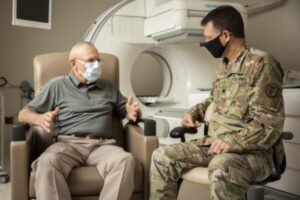
Army Lt. Col. Nathan McWhorter, DO, chief of Nuclear Medicine, consults with patient Harold G. Overstreet, retired Sgt. Maj. of the Marine Corps, last fall at Brooke Army Medical Center at Fort Sam Houston, TX. Overstreet is undergoing a new treatment for prostate cancer patients which is combined with a specific type of positron emission tomography (PET) imaging agent for prostate cancer. U.S. Army photo by Jason W. Edwards
BETHESDA, MD — Prostate cancer is the third-most-common cancer in men in the U.S. military and the second-leading cause of cancer mortality in U.S. men overall.
The five-year relative survival rate is nearly 100% for patients with local and regional prostate cancer, but the rate drops to about 30% for those with late stages of the disease.
Because accessibility to healthcare is an important factor in cancer prognosis and the U.S. Military Health System provides universal healthcare to its beneficiaries, researchers at the Uniformed Services University of the Health Sciences wanted to know whether the lack of barriers to care the system provides translates into improved survival among patients with advanced prostate cancer. The group’s earlier research on other cancers—including lung, breast, colon and glioma—showed that survival of patients with these cancers was longer among the MHS beneficiaries than similar patients in the U.S. population.
To learn whether the same was true for advanced prostate cancer, the researchers identified 5,379 MHS patients with Stages III and IV prostate cancer from the DoD’s Automated Central Tumor Registry (ACTUR), which contains information on demographics, cancer diagnosis, tumor characteristics, cancer treatment, follow-up, vital status and other data from cancer patients diagnosed or treated at military treatment facilities. They identified 21,516 counterparts in the general population from the Surveillance, Epidemiology, and End Results (SEER) a cancer registry program of the National Cancer Institute which collects population-based cancer data in SEER-served cancer registries. Four SEER patients were matched to each ACTUR patient on age, race and diagnosis year to control for the potential effects of these factors on research results.1
The follow-up period was from diagnosis date to up to five years after diagnosis for both ACTUR and SEER patients. All-cause death was the study outcome. The researchers analyzed the survival data by using the Multivariable Cox regression hazard model for matched data to estimate hazard ratios and 95% confidence intervals comparing ACTUR to SEER.
All Tumor Stages
Their findings: regardless of age, race and tumor stage at diagnosis, patients with late-stage prostate cancer in the MHS had improved five-year survival when compared with those in the general population. “This improved survival was observed for ages 50 years or older, both whites and Blacks, all tumor stages and grades,” said Gregory T. Chesnut, MD, assistant professor of surgery at USU and a member of the research team. “The lower risk of death in ACTUR than SEER tended to be more evident for Blacks than whites—32% vs. 25%—although the difference was not statistically significant. Also, this survival benefit was applicable whether the patients were primarily treated with surgery or radiation therapy,” he said.
Universal access to healthcare provided by MHS may be one of various factors related to the study’s findings, said Chesnut, who also serves as director of the Center for Prostate Disease Research and director of Urologic Oncology at Walter Reed National Military Medical Center. “Universal care reduces barriers to the utilization of cancer screening and receipt of timely treatment.” He added that factors at the health system level—such as improved access to screening/treatment/follow-up care or possibly the more ready availability of multidisciplinary treatment teams within the MHS—may also be related to the survival benefit.
“Our findings imply the significance of reducing barriers to health care for improving survival of patients with late-stage prostate cancer,” said Kangmin Zhu, MD, PhD, of the John P. Murtha Cancer Center, Walter Reed National Military Medical Center, another member of the team who published their results in the British Journal of Cancer. “The study findings also suggest that further research on other factors associated with the observed differences is needed.”
- Lin J, Nousome D, Jiang J, Chesnut GT, Shriver CD, Zhu K. Five-year survival of patients with late-stage prostate cancer: comparison of the Military Health System and the U.S. general population. Br J Cancer. 2023 Jan 6. doi: 10.1038/s41416-022-02136-3. Epub ahead of print. PMID: 36609596.

